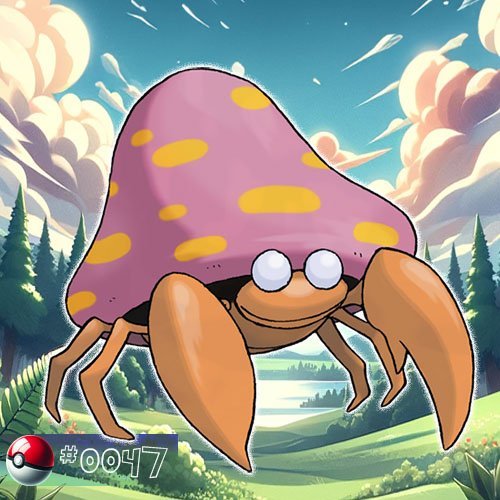Paras
Paras is a Bug/Grass-type Pokémon. It resembles a small insect with mushrooms growing on its back.
Biology
Physical Characteristics
Paras is known for its unique and intriguing physical characteristics.
Paras is relatively small, with an orange, segmented body. It has four short legs, giving it a distinctive insect-like appearance. Paras features a pair of crab-like pincers at the front. Paras has white eyes with black pupils, giving it a cute yet somewhat otherworldly expression.
The most notable feature is the pair of mushrooms growing on its back. These mushrooms are integral to Paras’s biology. The mushrooms form a symbiotic relationship with Paras, drawing nutrients and providing unique abilities.
Paras evolves into Parasect, a Bug/Grass-type Pokémon, at a certain level. During evolution, the mushrooms on Paras’s back fully take over, turning into a large mushroom on Parasect’s back. The mushrooms release spores that have various effects, including inducing sleep. Paras is often found in forests, particularly those with damp conditions where mushrooms thrive.
Behaviour
Paras exhibits various behaviors influenced by its natural instincts and environment.
Paras primarily feeds on plant matter, especially in the form of tree sap. It uses its pincers to attach to tree trunks and drain nutrients, similar to a parasitic relationship.
Paras is often encountered alone, and its behavior tends to be solitary rather than social. It may show territorial tendencies, especially when it comes to securing a feeding spot on a tree.
The mushrooms on its back have a symbiotic relationship with Paras. They benefit from each other, with the mushrooms drawing nutrients from Paras and providing unique abilities in return. The evolution into Parasect involves the mushrooms taking over completely, showcasing a profound change in behavior during the evolutionary process.
Paras employs its crab-like pincers for defense against potential threats. In self-defense, Paras can release sleep-inducing spores from its mushrooms to escape from danger. Paras prefers forested areas, especially those with damp conditions, reflecting its adaptation to specific habitats. Some sources suggest that Paras becomes more active during the night, adjusting its behavior to a nocturnal cycle.
Upon evolution into Parasect, the behavior of Paras undergoes a significant change as the mushrooms take over. This evolution may impact its instincts, habits, and interactions with the environment.
Understanding these behavioral characteristics sheds light on how Paras navigates its surroundings, interacts with other Pokémon, and adapts to the challenges presented in its habitat.
Evolution
Paras is the base form in its evolutionary line, characterized by its Bug/Grass typing and distinctive crab-like appearance. At this stage, Paras is often seen with a small mushroom sprouting from its back.
Paras evolves into Parasect, the next stage in its evolution, based on gaining experience and reaching a certain level (usually level 24).
Parasect maintains its Bug/Grass typing, with adaptations in physical appearance and abilities. The most notable change is the mushroom on its back growing larger and taking control, signifying a more mature and evolved state.
The mushroom on Parasect’s back grows to overshadow its original body, indicating a takeover by the parasitic fungi. Parasect’s eyes become vacant and expressionless, while its claws and pincers appear more prominent and defined. The influence of the mushroom alters Parasect’s behavior, often described as more docile and less independent compared to Paras.
While Parasect gains enhanced strength and capabilities, the loss of individual control and autonomy is a significant trade-off. Parasect gains the ability to release sleep-inducing spores from its mushroom. This adaptation serves as both a defense mechanism and a tool for escaping threats.
Both Paras and Parasect are adapted to forested environments, with Parasect often found in darker, damper areas. The relationship between Paras and its mushrooms evolves into a more symbiotic connection, with the fungi gaining dominance in the parasitic partnership.
Understanding the evolutionary progression from Paras to Parasect involves recognizing not only the physical changes but also the behavioral and ecological adaptations that accompany this transformation.
Appearances
Anime Main Appearances
In the episode “The Problem with Paras”, Cassandra, one of the owners of a medicine shop in Mossgreen Village, possesses a frail Paras, crucial for evolving into Parasect to utilize its large mushroom for medical research. The evolution occurs towards the episode’s conclusion.
Anime Minor Appearances
In various episodes, Paras is encountered in different locations, such as the Pokémon Theme Park (“Pikachu’s Vacation”), Pinkan Island (“In the Pink”), and Murcott Island (“Tracey Gets Bugged”). In “Bulbasaur and the Hidden Village”, a Paras cared for by Melanie is featured, later seen in a flashback. In “Pokémon Fashion Flash” one was spotted on Scissor Street.
Another Paras appeared in “A Chansey Operation” and “The Breeding Center Secret”. In the episode “The Fortune Hunters” a Paras was stolen by Butch and Cassidy. Misty encountered and scared away a Paras in “The Bug Stops Here”. Paras also appeared in various movies and episodes, and Goh caught one in “Working My Way Back to Mew”.
Multiple Paras appeared in the following episodes:
- ”Clefairy and the Moon Stone” (made their first appearence in this episode where were seen removing the mushrooms on their backs)
- ”Showdown at the Po-ké Corral” (seen living at the laboratory of Professor Oak)
- ”Genesect and the Legend Awakened” (seen as residents of Pokémon Hills)
- ”Alola, Kanto!” (at the laboratory of Professor Oak)
- ”Trade, Borrow, and Steal!” (in a fantasy)
A Coordinator’s Paras appeares in the episodes ”Harley Rides Again” and ”Once More With Reeling!” (participated in the Terracotta Contest).
A Trainer’s Paras appeares also in the following epsodes:
- “The Grass Route” (participated in the Grass Tournament)
- “Alola to New Adventure!”
- “A Young Royal Flame Ignites!”
- “The Power of Us” (four of five Paras in this episode were owned by deifferent Trainers)
- “Securing the Future!” (two of three Paras in this episode were owned by different Trainers)
- ”Take My Thief! Please!”
Manga Appearances
Pokémon Adventures
In “Purrrr-sian,” Super Nerd Miles, posing as Red, deployed a Paras in an attempt to capture Pika while attacking with his Persian and Marowak. Additionally, in “The Last Battle XIII,” a Paras joined the battle in Ilex Forest.
Pokémon Gold & Silver: The Golden Boys
In the episode ”Let’s Fight For The Future!!”, the twenty-third and final chapter of the Pokémon Gold & Silver: The Golden Boys manga, appeares a Paras owned ba a Trainer.
Pokémon Gotta Catch ‘Em All
A Paras was seen in the episodes ”A Match For Pokémon” and ”The Challenge at Celadon University!”.
Game data
Stats
Location
| Game version | Location |
|---|---|
| Pokémon Red and Pokémon Blue | Mt. Moon, Safari Zone |
| Pokémon Yellow | Mt. Moon, Safari Zone |
| Pokémon Gold and Pokémon Silver | Ilex Forest, Mt. Moon, National Park (Bug-Catching Contest) |
| Pokémon Crystal | Ilex Forest, Mt. Moon, National Park (Bug-Catching Contest) |
| Pokémon Ruby and Pokémon Sapphire | Trade |
| Pokémon FireRed and Pokémon LeafGreen | Mt. Moon, Safari Zone |
| Pokémon Emerald | Trade |
| Pokémon Colosseum | Trade |
| Pokémon XD | Cipher Key Lair |
| Pokémon Diamond and Pokémon Pearl | Great Marsh |
| Pokémon Platinum | Great Marsh |
| Pokémon HeartGold and Pokémon SoulSilver | Ilex Forest, Mt. Moon, National Park (Bug-Catching Contest) |
| Pokémon Black | Trade |
| Pokémon White | Route 11 |
| Pokémon Black 2 and Pokémon White 2 | Trade |
| Pokémon X and Pokémon Y | Friend Safari |
| Pokémon Omega Ruby and Pokémon Alpha Sapphire | Petalburg Woods |
| Pokémon Sun and Pokémon Moon | Route 11, Brooklet Hill, Lush Jungle |
| Pokémon Ultra Sun and Pokémon Ultra Moon | Brooklet Hill, Lush Jungle |
| Pokémon: Let's Go, Pikachu! And Pokémon: Let's Go, Eevee! | Mt. Moon |
| Pokémon Sword and Pokémon Shield | Unobtainable |
| Pokémon Brilliant Diamond and Pokémon Shining Pearl | Grassland Cave, Swampy Cave, Sunlit Cavern, Bogsunk Cavern |
| Legends Arceus | Nature’s Pantry, Cloudpool Ridge, Cottonsedge Prairie, Diamond Heath, Golden Lowlands, Heavenward Lookout, Wayward Wood, Windbreak Stand |
| Pokémon Scarlet and Pokémon Violet | Unobtainable |
Paras's origin name
Across languages, the name tends to maintain a connection to the concept of parasitism, reflecting the Pokémon’s symbiotic relationship with the mushroom on its back. The slight variations in pronunciation and characters offer cultural adaptations while preserving the essential theme.
English: Paras’s English name is derived from “parasitic,” reflecting its parasitic nature.
Japanese: “Parasu” – The name is a combination of the English word “parasite” and the Japanese word for “mushroom” (キノコ, kinoko).
French: “Paras” – The French name maintains the root “Paras” from the English name.
German: “Paras” – The German name is identical to the English and French names.
Spanish: “Paras” – Similar to the French and English names, the Spanish name is “Paras.”
Italian: “Paras” – The Italian name is consistent with the English and French names, staying as “Paras.”
Korean: “파라스” (Paraseu) – The Korean name closely resembles the Japanese name “Parasu.”
Chinese (Simplified): “派拉斯” (Pàilāsī) – The Simplified Chinese name follows a similar structure to the Japanese and Korean names.
Chinese (Traditional): “派拉斯” (Pàilāsī) – The Traditional Chinese name is the same as the Simplified Chinese version.




